Evolution of Deformation Fabrics Related to Petrogenesis of Upper Mantle Xenoliths Beneath the Baekdusan Volcano
Abstract
:1. Introduction
2. Geological Background and Sampling
3. Methods
3.1. Mineral Chemistry
3.2. Measurement of LPO
4. Results
4.1. Petrographic Features and Deformation Microstructures
4.2. Mineral Compositions and Equilibrium Temperatures
4.3. LPOs of Minerals
5. Discussion
5.1. The Genesis of Olivine Fabrics in the Upper Mantle
5.2. Petrogenesis and Evolution of Deformation Fabrics of the Baekdusan Peridotites
6. Conclusions
Author Contributions
Funding
Acknowledgments
Conflicts of Interest
References
- Bascou, J.; Doucet, L.S.; Saumet, S.; Ionov, D.A.; Ashchepkov, I.V.; Golovin, A.V. Seismic velocities, anisotropy and deformation in Siberian cratonic mantle: EBSD data on xenoliths from the Udachnaya kimberlite. Earth Planet. Sci. Lett. 2011, 304, 71–84. [Google Scholar] [CrossRef]
- Wu, F.-Y.; Yang, J.-H.; Xu, Y.-G.; Wilde, S.A.; Walker, R.J. Destruction of the North China Craton in the Mesozoic. Annu. Rev. Earth Planet. Sci. 2019, 47, 173–195. [Google Scholar] [CrossRef]
- Liu, J.; Cai, R.; Pearson, D.G.; Scott, J.M. Thinning and destruction of the lithospheric mantle root beneath the North China Craton: A review. Earth Sci. Rev. 2019, 196, 102873. [Google Scholar] [CrossRef]
- Tang, Y.-J.; Zhang, H.-F.; Ying, J.-F.; Su, B.-X. Widespread refertilization of cratonic and circum-cratonic lithospheric mantle. Earth Sci. Rev. 2013, 118, 45–68. [Google Scholar] [CrossRef]
- Frey, F.A.; Green, D.H. The mineralogy, geochemistry and origin of Iherzolite inclusions in Victorian basanites. Geochim. Cosmochim. Acta 1974, 38, 1023–1059. [Google Scholar] [CrossRef]
- Jordan, T.H. The continental tectosphere. Rev. Geophys. 1975, 13, 1–12. [Google Scholar] [CrossRef]
- King, S.D. Archean cratons and mantle dynamics. Earth Planet. Sci. Lett. 2005, 234, 1–14. [Google Scholar] [CrossRef]
- Griffin, W.L.; O’Reilly, S.Y.; Afonso, J.C.; Begg, G.C. The Composition and Evolution of Lithospheric Mantle: A Re-evaluation and its Tectonic Implications. J. Petrol. 2009, 50, 1185–1204. [Google Scholar] [CrossRef] [Green Version]
- Mercier, J.-C.C.; Nicolas, A. Textures and fabrics of upper-mantle peridotites as illustrated by xenoliths from basalts. J. Petrol. 1975, 16, 454–487. [Google Scholar] [CrossRef]
- Jung, H. Crystal preferred orientations of olivine, orthopyroxene, serpentine, chlorite, and amphibole, and implications for seismic anisotropy in subduction zones: A review. Geosci. J. 2017, 21, 985–1011. [Google Scholar] [CrossRef]
- Park, M.; Berkesi, M.; Jung, H.; Kil, Y. Fluid infiltration in the lithospheric mantle beneath the Rio Grande Rift, USA: A fluid-inclusion study. Eur. J. Mineral. 2017. [Google Scholar] [CrossRef] [Green Version]
- Park, M.; Jung, H.; Kil, Y. Petrofabrics of olivine in a rift axis and rift shoulder and their implications for seismic anisotropy beneath the Rio Grande rift. Isl. Arc 2014, 23, 299–311. [Google Scholar] [CrossRef]
- Park, Y.; Jung, H. Deformation microstructures of olivine and pyroxene in mantle xenoliths in Shanwang, eastern China, near the convergent plate margin, and implications for seismic anisotropy. Int. Geol. Rev. 2015, 57, 629–649. [Google Scholar] [CrossRef]
- Jung, H.; Karato, S. Water-induced fabric transitions in olivine. Science 2001, 293, 1460–1463. [Google Scholar] [CrossRef] [PubMed] [Green Version]
- Katayama, I.; Jung, H.; Karato, S.I. New type of olivine fabric from deformation experiments at modest water content and low stress. Geology 2004, 32, 1045–1048. [Google Scholar] [CrossRef] [Green Version]
- Jung, H.; Katayama, I.; Jiang, Z.; Hiraga, I.; Karato, S. Effect of water and stress on the lattice-preferred orientation of olivine. Tectonophysics 2006, 421, 1–22. [Google Scholar] [CrossRef]
- Katayama, I.; Karato, S. Effect of temperature on the B- to C-type olivine fabric transition and implication for flow pattern in subduction zones. Phys. Earth Planet. Inter. 2006, 157, 33–45. [Google Scholar] [CrossRef]
- Mainprice, D.; Tommasi, A.; Couvy, H.; Cordier, P.; Frost, D.J. Pressure sensitivity of olivine slip systems and seismic anisotropy of Earth’s upper mantle. Nature 2005, 433, 731–733. [Google Scholar] [CrossRef]
- Jung, H.; Mo, W.; Green, H.W. Upper mantle seismic anisotropy resulting from pressure-induced slip transition in olivine. Nat. Geosci. 2009, 2, 73–77. [Google Scholar] [CrossRef]
- Ohuchi, T.; Kawazoe, T.; Nishihara, Y.; Nishiyama, N.; Irifune, T. High pressure and temperature fabric transitions in olivine and variations in upper mantle seismic anisotropy. Earth Planet. Sci. Lett. 2011, 304, 55–63. [Google Scholar] [CrossRef]
- Park, K.; Choi, S.H.; Cho, M.; Lee, D.-C. Evolution of the lithospheric mantle beneath Mt. Baekdu (Changbaishan): Constraints from geochemical and Sr-Nd-Hf isotopic studies on peridotite xenoliths in trachybasalt. Lithos 2017, 286–287, 330–344. [Google Scholar] [CrossRef]
- Choi, H.-O.; Choi, S.H.; Lee, Y.S.; Ryu, J.-S.; Lee, D.-C.; Lee, S.-G.; Sohn, Y.K.; Liu, J.-Q. Petrogenesis and mantle source characteristics of the late Cenozoic Baekdusan (Changbaishan) basalts, North China Craton. Gondwana Res. 2020, 78, 156–171. [Google Scholar] [CrossRef]
- Wu, F.-Y.; Walker, R.J.; Ren, X.-W.; Sun, D.-Y.; Zhou, X.-H. Osmium isotopic constraints on the age of lithospheric mantle beneath northeastern China. Chem. Geol. 2003, 196, 107–129. [Google Scholar] [CrossRef]
- Kuritani, T.; Kimura, J.-I.; Ohtani, E.; Miyamoto, H.; Furuyama, K. Transition zone origin of potassic basalts from Wudalianchi volcano, northeast China. Lithos 2013, 156–159, 1–12. [Google Scholar] [CrossRef]
- Liu, D.Y.; Nutman, A.P.; Compston, W.; Wu, J.S.; Shen, Q.H. Remnants of ≥3800 Ma crust in the Chinese part of the Sino-Korean craton. Geology 1992, 20, 339–342. [Google Scholar] [CrossRef]
- Liu, D.; Wilde, S.A.; Wan, Y.; Wu, J.; Zhou, H.; Dong, C.; Yin, X. New U-Pb and Hf isotopic data confirm Anshan as the oldest preserved segment of the North China Craton. Am. J. Sci. 2008, 308, 200–231. [Google Scholar] [CrossRef]
- Zhao, G.; Wilde, S.A.; Cawood, P.A.; Sun, M. Archean blocks and their boundaries in the North China Craton: Lithological, geochemical, structural and P–T path constraints and tectonic evolution. Precambrian Res. 2001, 107, 45–73. [Google Scholar] [CrossRef]
- Yang, J.-H.; Wu, F.-Y.; Wilde, S.A.; Belousova, E.; Griffin, W.L. Mesozoic decratonization of the North China block. Geology 2008, 36, 467–470. [Google Scholar] [CrossRef]
- Wu, F.-Y.; Lin, J.-Q.; Wilde, S.A.; Zhang, X.O.; Yang, J.-H. Nature and significance of the Early Cretaceous giant igneous event in eastern China. Earth Planet. Sci. Lett. 2005, 233, 103–119. [Google Scholar] [CrossRef]
- Wu, F.-Y.; Yang, J.-H.; Wilde, S.A.; Zhang, X.-O. Geochronology, petrogenesis and tectonic implications of Jurassic granites in the Liaodong Peninsula, NE China. Chem. Geol. 2005, 221, 127–156. [Google Scholar] [CrossRef]
- Zou, H.; Zindler, A.; Xu, X.; Qi, Q. Major, trace element, and Nd, Sr and Pb isotope studies of Cenozoic basalts in SE China: Mantle sources, regional variations, and tectonic significance. Chem. Geol. 2000, 171, 33–47. [Google Scholar] [CrossRef] [Green Version]
- Cheong, A.C.-S.; Jeong, Y.-J.; Jo, H.J.; Sohn, Y.K. Recurrent Quaternary magma generation at Baekdusan (Changbaishan) volcano: New zircon U-Th ages and Hf isotopic constraints from the Millennium Eruption. Gondwana Res. 2019, 68, 13–21. [Google Scholar] [CrossRef]
- Zhao, D.; Tian, Y.; Lei, J.; Liu, L.; Zheng, S. Seismic image and origin of the Changbai intraplate volcano in East Asia: Role of big mantle wedge above the stagnant Pacific slab. Phys. Earth Planet. Inter. 2009, 173, 197–206. [Google Scholar] [CrossRef]
- Tang, Y.; Obayashi, M.; Niu, F.; Grand, S.P.; Chen, Y.J.; Kawakatsu, H.; Tanaka, S.; Ning, J.; Ni, J.F. Changbaishan volcanism in northeast China linked to subduction-induced mantle upwelling. Nat. Geosci. 2014, 7, 470–475. [Google Scholar] [CrossRef]
- Kuritani, T.; Xia, Q.-K.; Kimura, J.-I.; Liu, J.; Shimizu, K.; Ushikubo, T.; Zhao, D.; Nakagawa, M.; Yoshimura, S. Buoyant hydrous mantle plume from the mantle transition zone. Sci. Rep. 2019, 9, 6549. [Google Scholar] [CrossRef] [Green Version]
- Wei, H.; Liu, G.; Gill, J. Review of eruptive activity at Tianchi volcano, Changbaishan, northeast China: Implications for possible future eruptions. Bull. Volcanol. 2013, 75, 706. [Google Scholar] [CrossRef]
- Wei, H.; Sparks, R.S.J.; Liu, R.; Fan, Q.; Wang, Y.; Hong, H.; Zhang, H.; Chen, H.; Jiang, C.; Dong, J.; et al. Three active volcanoes in China and their hazards. J. Asian Earth Sci. 2003, 21, 515–526. [Google Scholar] [CrossRef]
- Wei, H.; Wang, Y.; Jin, J.; Gao, L.; Yun, S.-H.; Jin, B. Timescale and evolution of the intracontinental Tianchi volcanic shield and ignimbrite-forming eruption, Changbaishan, Northeast China. Lithos 2007, 96, 315–324. [Google Scholar] [CrossRef]
- Brey, G.P.; Köhler, T. Geothermobarometry in four-phase lherzolites II. New thermobarometers, and practical assessment of existing thermobarometers. J. Petrol. 1990, 31, 1353–1378. [Google Scholar] [CrossRef]
- Park, M.; Jung, H. Relationships between eclogite-facies mineral assemblages, deformation microstructures, and seismic properties in the Yuka Terrane, North Qaidam Ultrahigh-Pressure Metamorphic Belt, NW China. J. Geophys. Res. Solid Earth 2019, 124, 13168–13191. [Google Scholar] [CrossRef]
- Park, M.; Jung, H. Analysis of electron backscattered diffraction (EBSD) mapping of geological materials: Precautions for reliably collecting and interpreting data on petro-fabric and seismic anisotropy. Geosci. J. 2020. [Google Scholar] [CrossRef]
- Skemer, P.; Katayama, I.; Jiang, Z.; Karato, S.-I. The misorientation index: Development of a new method for calculating the strength of lattice-preferred orientation. Tectonophysics 2005, 411, 157–167. [Google Scholar] [CrossRef]
- Amiguet, E.; Raterron, P.; Cordier, P.; Couvy, H.; Chen, J.C. Deformation of diopside single crystal at mantle pressure 1: Mechanical data. Phys. Earth Planet. Inter. 2009, 177, 122–129. [Google Scholar] [CrossRef] [Green Version]
- Helmstaedt, H.; Anderson, O.L.; Gavasci, A.T. Petrofabric studies of eclogite, spinel-Websterite, and spinel-lherzolite Xenoliths from kimberlite-bearing breccia pipes in southeastern Utah and northeastern Arizona. J. Geophys. Res. 1972, 77, 4350–4365. [Google Scholar] [CrossRef]
- Van der Wal, D.; Chopra, P.; Drury, M.; Gerald, J.F. Relationships between dynamically recrystallized grain size and deformation conditions in experimentally deformed olivine rocks. Geophys. Res. Lett. 1993, 20, 1479–1482. [Google Scholar] [CrossRef]
- Nickel, K.G. Phase equilibria in the system SiO2-MgO-Al2O3-CaO-Cr2O3 (SMACCR) and their bearing on spinel/garnet lherzolite relationships. Neues Jahrb. Mineral. Abh. 1986, 155, 259–287. [Google Scholar]
- Webb, S.A.C.; Wood, B.J. Spinel-pyroxene-garnet relationships and their dependence on Cr/Al ratio. Contrib. Mineral. Petrol. 1986, 92, 471–480. [Google Scholar] [CrossRef]
- Arai, S. Characterization of spinel peridotites by olivine-spinel compositional relationships: Review and interpretation. Chem. Geol. 1994, 113, 191–204. [Google Scholar] [CrossRef]
- Dick, H.J.B.; Bullen, T. Chromian spinel as a petrogenetic indicator in abyssal and alpine-type peridotites and spatially associated lavas. Contrib. Mineral. Petrol. 1984, 86, 54–76. [Google Scholar] [CrossRef]
- Ishii, T.; Robinson, P.T.; Maekawa, H.; Fiske, R. Petrological studies of peridotites from diapiric serpentinite seamounts in the Izu-Ogasawara-Mariana forearc, Leg 125. Proc. Ocean. Drill. Program Sci. Results 1992, 125, 445–485. [Google Scholar]
- Parkinson, I.J.; Pearce, J.A. Peridotites from the Izu-Bonin-Mariana Forearc (ODP Leg 125): Evidence for Mantle Melting and Melt—Mantle Interaction in a Supra-Subduction Zone Setting. J. Petrol. 1998, 39, 1577–1618. [Google Scholar] [CrossRef]
- Pearce, J.A.; Barker, P.F.; Edwards, S.J.; Parkinson, I.J.; Leat, P.T. Geochemistry and tectonic significance of peridotites from the South Sandwich arc-basin system, South Atlantic. Contrib. Mineral. Petrol. 2000, 139, 36–53. [Google Scholar] [CrossRef]
- Jung, H.; Park, M.; Jung, S.; Lee, J. Lattice preferred orientation, water content, and seismic anisotropy of orthopyroxene. J. Earth Sci. 2010, 21, 555–568. [Google Scholar] [CrossRef]
- Zhang, S.; Karato, S.-I. Lattice preferred orientation of olivine aggregates deformed in simple shear. Nature 1995, 375, 774–777. [Google Scholar] [CrossRef]
- Zhang, S.; Karato, S.-I.; Fitz Gerald, J.; Faul, U.H.; Zhou, Y. Simple shear deformation of olivine aggregates. Tectonophysics 2000, 316, 133–152. [Google Scholar] [CrossRef]
- Hansen, L.N.; Zimmerman, M.E.; Kohlstedt, D.L. The influence of microstructure on deformation of olivine in the grain-boundary sliding regime. J. Geophys. Res. Solid Earth 2012, 117, B09201. [Google Scholar] [CrossRef]
- Karato, S.; Jung, H.; Katayama, I.; Skemer, P. Geodynamic significance of seismic anisotropy of the upper mantle: New insights from laboratory studies. Annu. Rev. Earth Planet. Sci. 2008, 36, 59–95. [Google Scholar] [CrossRef] [Green Version]
- Michibayashi, K.; Mainprice, D. The Role of Pre-existing Mechanical Anisotropy on Shear Zone Development within Oceanic Mantle Lithosphere: An Example from the Oman Ophiolite. J. Petrol. 2004, 45, 405–414. [Google Scholar] [CrossRef] [Green Version]
- Jung, H.; Mo, W.; Choi, S.H. Deformation microstructures of olivine in peridotite from Spitsbergen, Svalbard and implications for seismic anisotropy. J. Metamorph. Geol. 2009, 27, 707–720. [Google Scholar] [CrossRef]
- Falus, G.; Tommasi, A.; Soustelle, V. The effect of dynamic recrystallization on olivine crystal preferred orientations in mantle xenoliths deformed under varied stress conditions. J. Struct. Geol. 2011, 33, 1528–1540. [Google Scholar] [CrossRef]
- Park, M.; Jung, H. Microstructural evolution of the Yugu peridotites in the Gyeonggi Massif, Korea: Implications for olivine fabric transition in mantle shear zones. Tectonophysics 2017, 709, 55–68. [Google Scholar] [CrossRef]
- Skemer, P.; Warren, J.M.; Kelemen, P.B.; Hirth, G. Microstructural and Rheological Evolution of a Mantle Shear Zone. J. Petrol. 2010, 51, 43–53. [Google Scholar] [CrossRef] [Green Version]
- Warren, J.M.; Hirth, G.; Kelemen, P.B. Evolution of olivine lattice preferred orientation during simple shear in the mantle. Earth Planet. Sci. Lett. 2008, 272, 501–512. [Google Scholar] [CrossRef] [Green Version]
- Linckens, J.; Herwegh, M.; Muntener, O. Linking temperature estimates and microstructures in deformed polymineralic mantle rocks. Geochem. Geophys. Geosyst. 2011, 12. [Google Scholar] [CrossRef]
- Linckens, J.; Herwegh, M.; Muntener, O.; Mercolli, I. Evolution of a polymineralic mantle shear zone and the role of second phases in the localization of deformation. J. Geophys. Res. Solid Earth 2011, 116. [Google Scholar] [CrossRef]
- Kaczmarek, M.-A.; Jonda, L.; Davies, H.L. Evidence of melting, melt percolation and deformation in a supra-subduction zone (Marum ophiolite complex, Papua New Guinea). Contrib. Mineral. Petrol. 2015, 170, 1–23. [Google Scholar] [CrossRef]
- Bystricky, M.; Kunze, K.; Burlini, L.; Burg, J.-P. High Shear Strain of Olivine Aggregates: Rheological and Seismic Consequences. Science 2000, 290, 1564–1567. [Google Scholar] [CrossRef] [Green Version]
- Tommasi, A.; Tikoff, B.; Vauchez, A. Upper mantle tectonics: Three-dimensional deformation, olivine crystallographic fabrics and seismic properties. Earth Planet. Sci. Lett. 1999, 168, 173–186. [Google Scholar] [CrossRef]
- Tommasi, A.; Mainprice, D.; Canova, G.; Chastel, Y. Viscoplastic self-consistent and equilibrium-based modeling of olivine lattice preferred orientations: Implications for the upper mantle seismic anisotropy. J. Geophys. Res. Solid Earth 2000, 105, 7893–7908. [Google Scholar] [CrossRef] [Green Version]
- Hansen, L.N.; Zhao, Y.-H.; Zimmerman, M.E.; Kohlstedt, D.L. Protracted fabric evolution in olivine: Implications for the relationship among strain, crystallographic fabric, and seismic anisotropy. Earth Planet. Sci. Lett. 2014, 387, 157–168. [Google Scholar] [CrossRef]
- Higgie, K.; Tommasi, A. Deformation in a partially molten mantle: Constraints from plagioclase lherzolites from Lanzo, western Alps. Tectonophysics 2014, 615–616, 167–181. [Google Scholar] [CrossRef]
- Yang, Y.; Abart, R.; Yang, X.; Shang, Y.; Ntaflos, T.; Xu, B. Seismic anisotropy in the Tibetan lithosphere inferred from mantle xenoliths. Earth Planet. Sci. Lett. 2019, 515, 260–270. [Google Scholar] [CrossRef]
- Balling, N. Heat flow and thermal structure of the lithosphere across the Baltic Shield and northern Tornquist Zone. Tectonophysics 1995, 244, 13–50. [Google Scholar] [CrossRef]
- Jiang, G.; Hu, S.; Shi, Y.; Zhang, C.; Wang, Z.; Hu, D. Terrestrial heat flow of continental China: Updated dataset and tectonic implications. Tectonophysics 2019, 753, 36–48. [Google Scholar] [CrossRef]
- Kim, S.; Tkalčić, H.; Rhie, J. Seismic constraints on magma evolution beneath Mount Baekdu (Changbai) volcano from transdimensional Bayesian inversion of ambient noise data. J. Geophys. Res. Solid Earth 2017, 122, 5452–5473. [Google Scholar] [CrossRef]
- O’Reilly, S.Y.; Griffin, W.L. 4-D Lithosphere Mapping: Methodology and examples. Tectonophysics 1996, 262, 3–18. [Google Scholar] [CrossRef]
- Hellebrand, E.; Snow, J.E.; Dick, H.J.B.; Hofmann, A.W. Coupled major and trace elements as indicators of the extent of melting in mid-ocean-ridge peridotites. Nature 2001, 410, 677–681. [Google Scholar] [CrossRef]
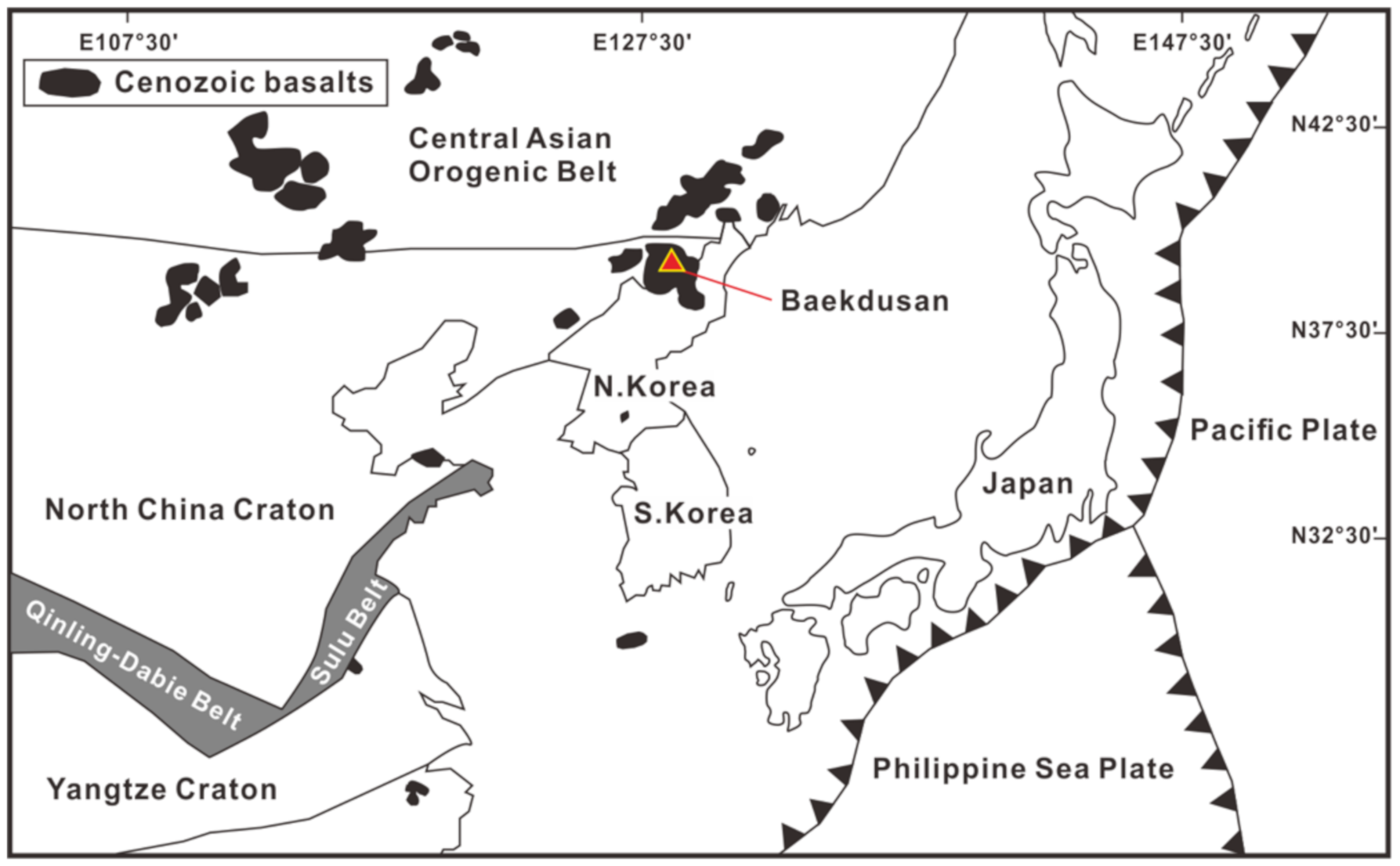
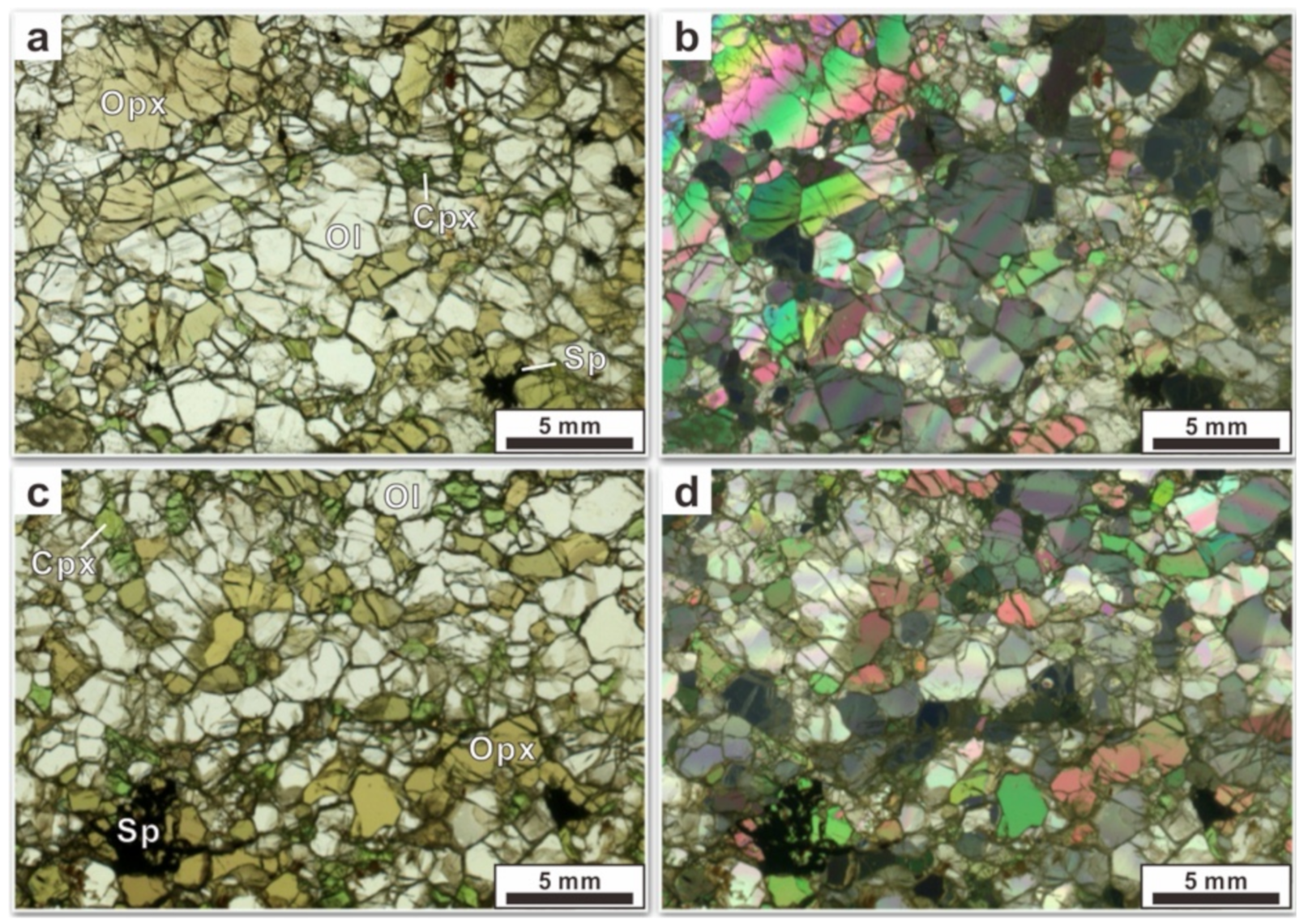

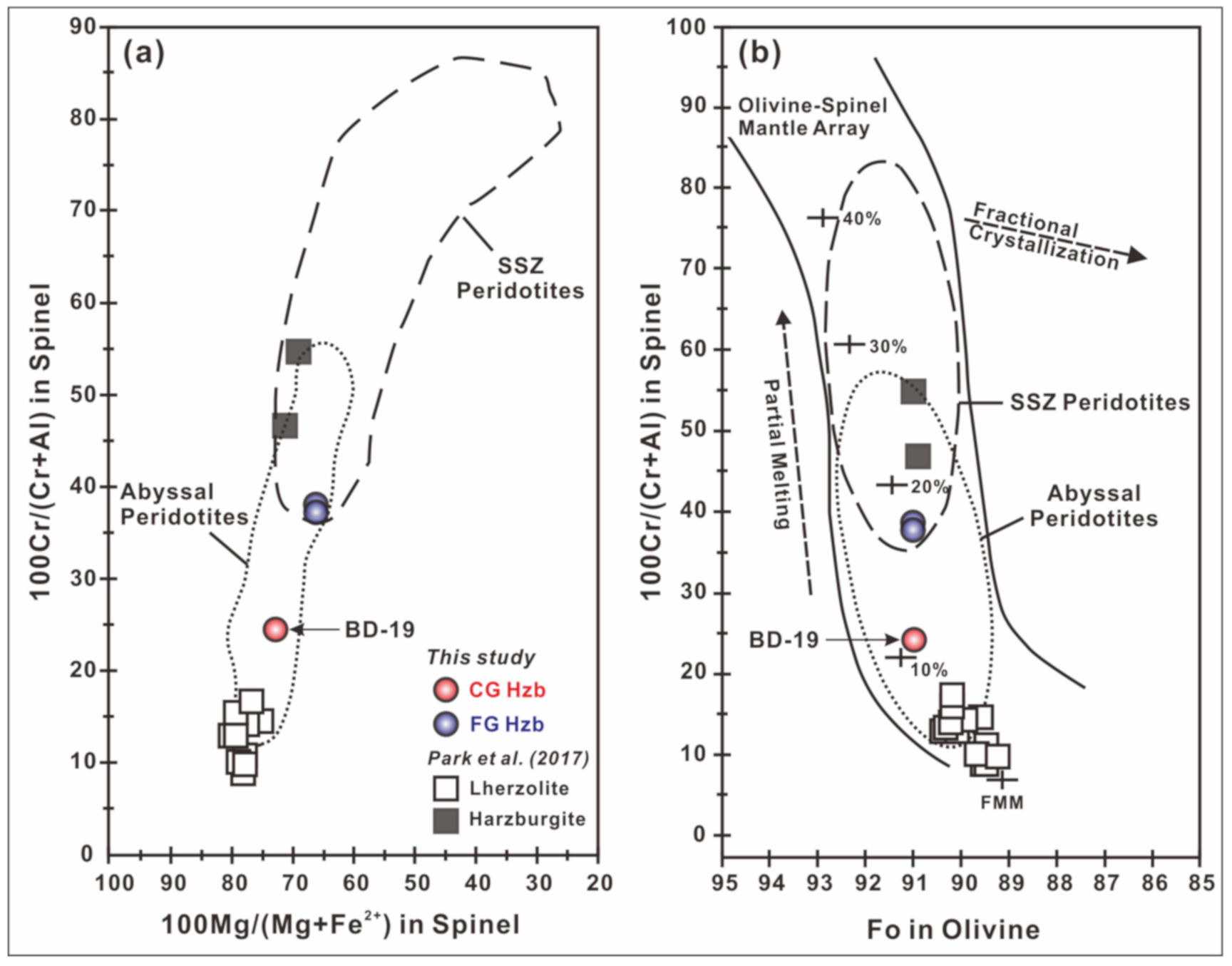
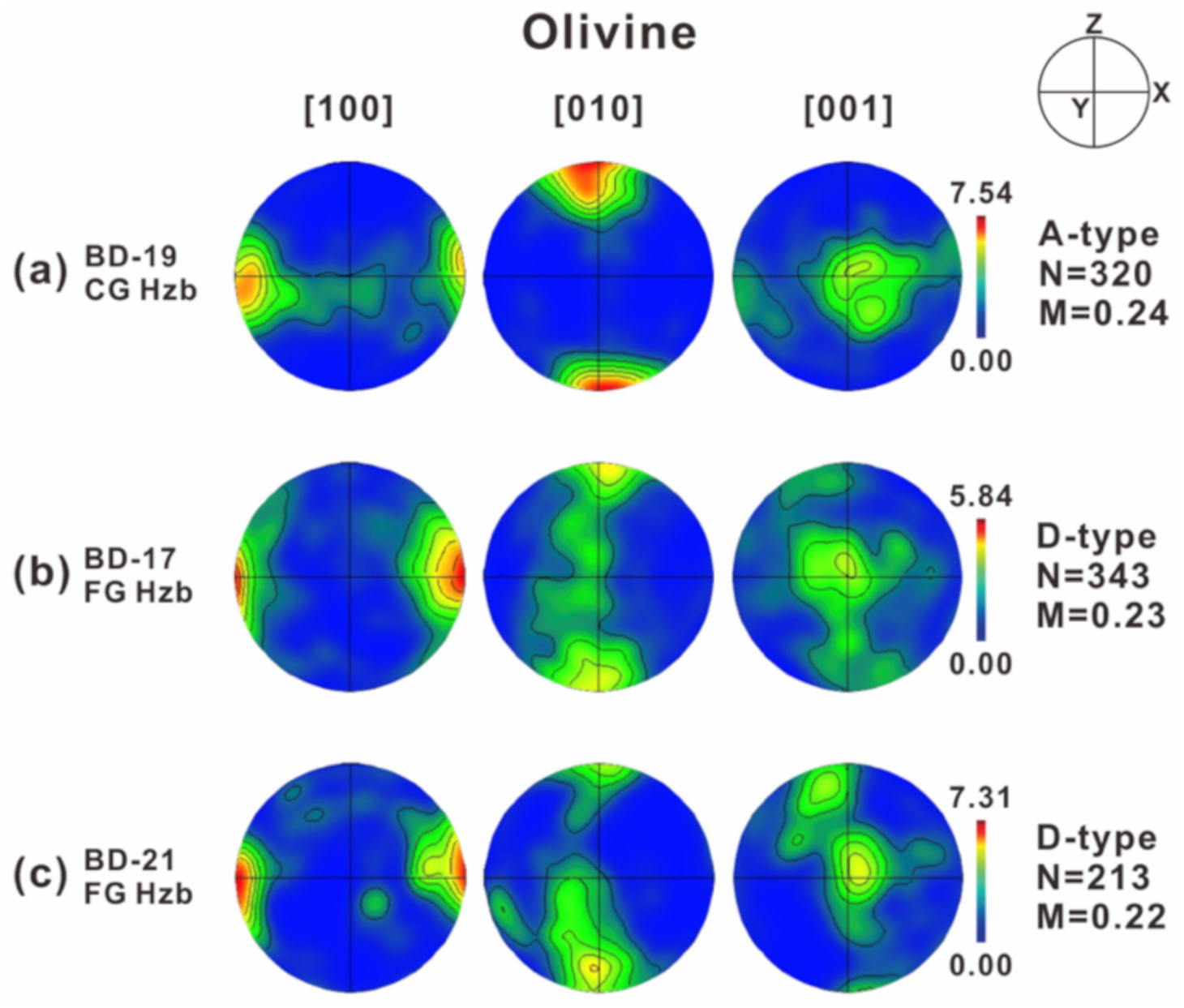
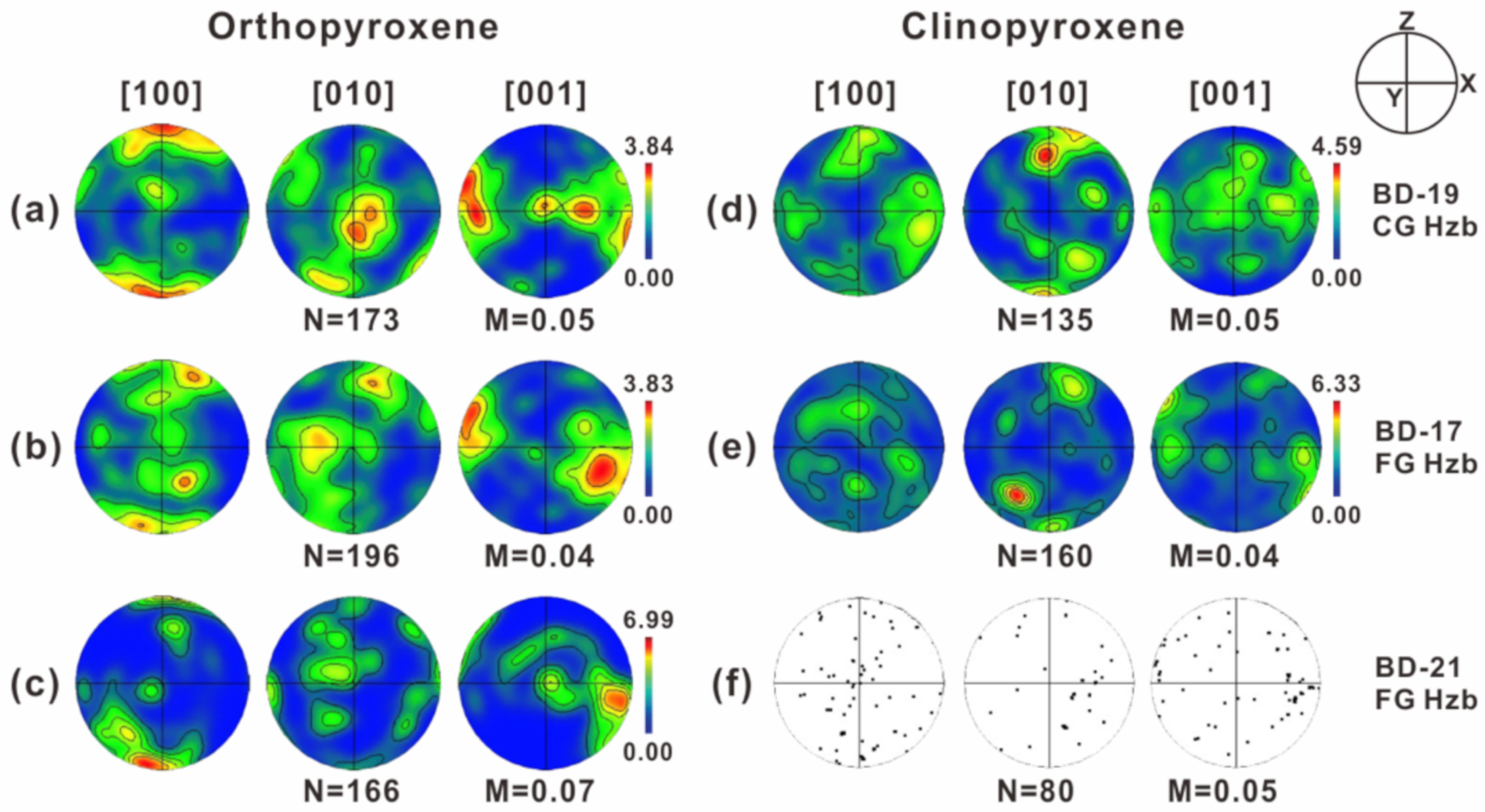
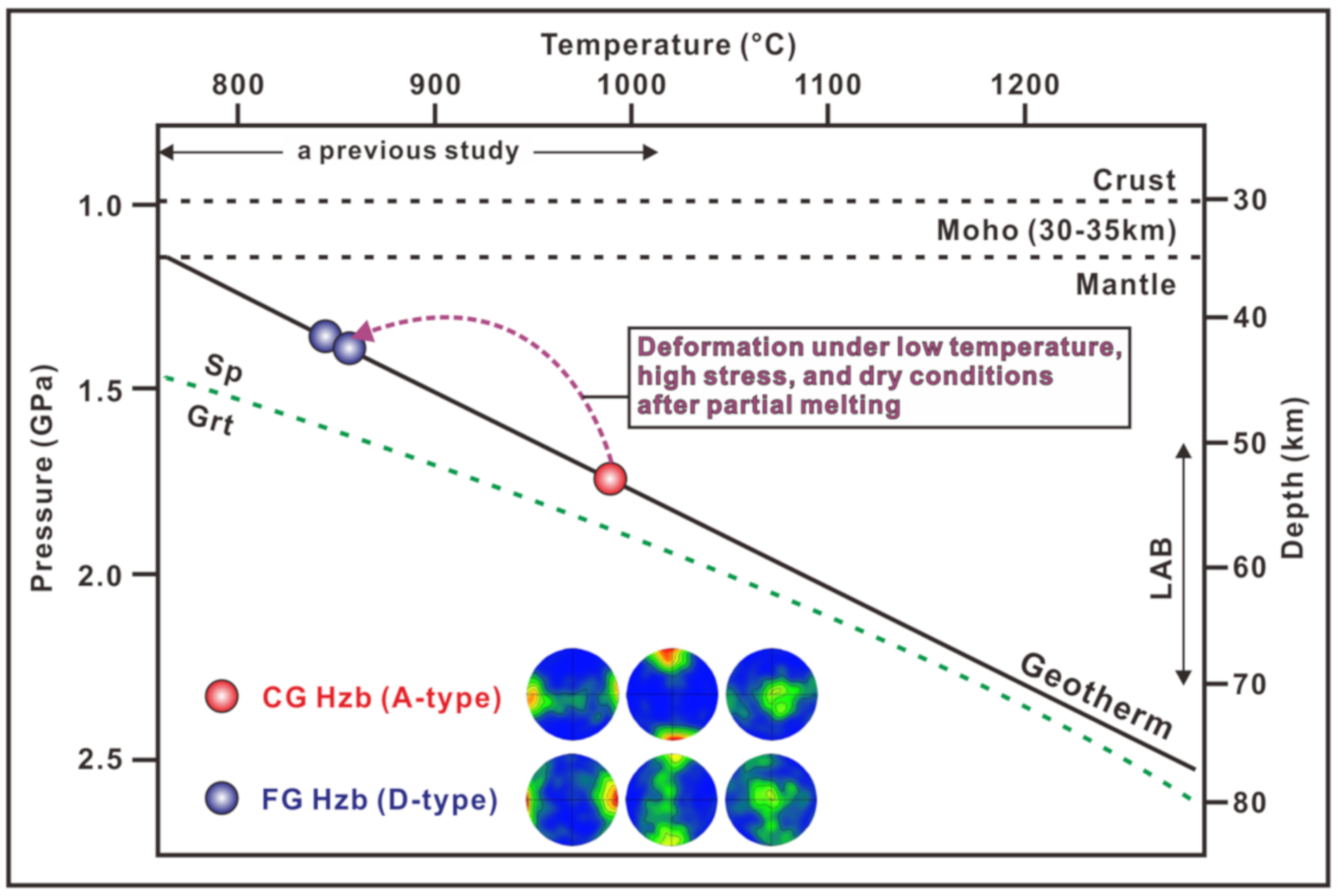
| Sample | Rock | Texture | Modal Composition 1 (%) | T 2 | GS 3 | Stress 4 | Olivine LPO | ||||
|---|---|---|---|---|---|---|---|---|---|---|---|
| Ol | Opx | Cpx | Sp | (°C) | (μm) | (MPa) | LPO | M 5 | |||
| BD-19 | Hzb | CG | 71.0 | 23.4 | 5.0 | 0.6 | 992 | 864 ± 86 | 9 | A-type | 0.24 |
| BD-17 | Hzb | FG | 62.0 | 33.7 | 4.0 | 0.3 | 855 | 384 ± 52 | 16 | D-type | 0.23 |
| BD-21 | Hzb | FG | 74.8 | 21.0 | 4.0 | 0.3 | 845 | 452 ± 45 | 14 | D-type | 0.22 |
| Sample | BD-19 | BD-17 | BD-21 | |||||||||
|---|---|---|---|---|---|---|---|---|---|---|---|---|
| Rock | Harzburgite | Harzburgite | Harzburgite | |||||||||
| Texture | Coarse-Granular | Fine-Granular | Fine-Granular | |||||||||
| Mineral | Ol | Opx | Cpx | Sp | Ol | Opx | Cpx | Sp | Ol | Opx | Cpx | Sp |
| SiO2 (wt%) | 41.26 | 55.09 | 52.60 | - | 41.20 | 56.65 | 53.69 | - | 40.75 | 56.11 | 53.53 | - |
| TiO2 | - | 0.04 | 0.09 | 0.10 | - | 0.04 | 0.11 | 0.06 | - | - | 0.08 | 0.09 |
| Al2O3 | - | 3.92 | 4.09 | 46.56 | - | 2.63 | 2.71 | 35.53 | - | 2.65 | 2.72 | 35.90 |
| Cr2O3 | - | 0.60 | 0.81 | 21.98 | - | 0.47 | 0.82 | 32.91 | - | 0.47 | 0.87 | 32.22 |
| FeO* | 8.73 | 6.08 | 2.88 | 12.13 | 9.02 | 5.87 | 2.13 | 14.48 | 8.99 | 5.69 | 2.03 | 14.69 |
| MnO | 0.10 | 0.21 | 0.12 | 0.21 | 0.09 | 0.16 | 0.06 | 0.22 | 0.15 | 0.11 | 0.03 | 0.18 |
| MgO | 50.09 | 32.86 | 16.99 | 18.67 | 49.66 | 33.92 | 17.21 | 16.12 | 49.11 | 33.77 | 16.98 | 16.26 |
| CaO | 0.04 | 0.91 | 21.67 | - | 0.04 | 0.56 | 23.07 | - | 0.05 | 0.55 | 23.18 | - |
| Na2O | - | 0.05 | 0.55 | - | - | - | 0.47 | - | - | - | 0.39 | - |
| K2O | - | - | - | - | - | - | - | - | - | - | - | - |
| Total | 100.26 | 99.75 | 99.82 | 99.69 | 100.08 | 100.34 | 100.26 | 99.33 | 99.10 | 99.36 | 99.80 | 99.34 |
| Si | 1.002 | 1.909 | 1.911 | 0.000 | 1.004 | 1.944 | 1.941 | 0.000 | 1.003 | 1.943 | 1.944 | 0.000 |
| Ti | 0.000 | 0.001 | 0.003 | 0.002 | 0.000 | 0.001 | 0.003 | 0.001 | 0.001 | 0.000 | 0.002 | 0.002 |
| Al | 0.000 | 0.160 | 0.175 | 1.496 | 0.000 | 0.106 | 0.115 | 1.211 | 0.000 | 0.108 | 0.116 | 1.222 |
| Cr | 0.000 | 0.016 | 0.023 | 0.474 | 0.000 | 0.013 | 0.023 | 0.753 | 0.000 | 0.013 | 0.025 | 0.736 |
| Fe | 0.177 | 0.176 | 0.088 | 0.277 | 0.184 | 0.169 | 0.064 | 0.350 | 0.185 | 0.165 | 0.062 | 0.355 |
| Mn | 0.002 | 0.006 | 0.004 | 0.005 | 0.002 | 0.005 | 0.002 | 0.005 | 0.003 | 0.003 | 0.001 | 0.004 |
| Mg | 1.814 | 1.698 | 0.920 | 0.759 | 1.804 | 1.736 | 0.927 | 0.695 | 1.802 | 1.743 | 0.919 | 0.700 |
| Ca | 0.001 | 0.034 | 0.843 | 0.000 | 0.001 | 0.021 | 0.894 | 0.000 | 0.001 | 0.020 | 0.902 | 0.000 |
| Na | 0.000 | 0.003 | 0.039 | 0.001 | 0.000 | 0.002 | 0.033 | 0.001 | 0.000 | 0.000 | 0.027 | 0.000 |
| K | 0.000 | 0.000 | 0.000 | 0.000 | 0.000 | 0.000 | 0.000 | 0.000 | 0.000 | 0.000 | 0.000 | 0.000 |
| Sum | 2.997 | 4.003 | 4.007 | 3.014 | 2.996 | 3.996 | 4.003 | 3.017 | 2.996 | 3.996 | 3.998 | 3.019 |
| Mg# | 91.1 | 90.6 | 91.3 | 73.3 | 90.7 | 91.1 | 93.5 | 66.5 | 90.7 | 91.4 | 93.7 | 66.4 |
| Cr# | 9.2 | 11.7 | 24.1 | 10.8 | 16.8 | 38.3 | 10.6 | 17.6 | 37.6 | |||
© 2020 by the authors. Licensee MDPI, Basel, Switzerland. This article is an open access article distributed under the terms and conditions of the Creative Commons Attribution (CC BY) license (http://creativecommons.org/licenses/by/4.0/).
Share and Cite
Park, M.; Kil, Y.; Jung, H. Evolution of Deformation Fabrics Related to Petrogenesis of Upper Mantle Xenoliths Beneath the Baekdusan Volcano. Minerals 2020, 10, 831. https://doi.org/10.3390/min10090831
Park M, Kil Y, Jung H. Evolution of Deformation Fabrics Related to Petrogenesis of Upper Mantle Xenoliths Beneath the Baekdusan Volcano. Minerals. 2020; 10(9):831. https://doi.org/10.3390/min10090831
Chicago/Turabian StylePark, Munjae, Youngwoo Kil, and Haemyeong Jung. 2020. "Evolution of Deformation Fabrics Related to Petrogenesis of Upper Mantle Xenoliths Beneath the Baekdusan Volcano" Minerals 10, no. 9: 831. https://doi.org/10.3390/min10090831
APA StylePark, M., Kil, Y., & Jung, H. (2020). Evolution of Deformation Fabrics Related to Petrogenesis of Upper Mantle Xenoliths Beneath the Baekdusan Volcano. Minerals, 10(9), 831. https://doi.org/10.3390/min10090831







